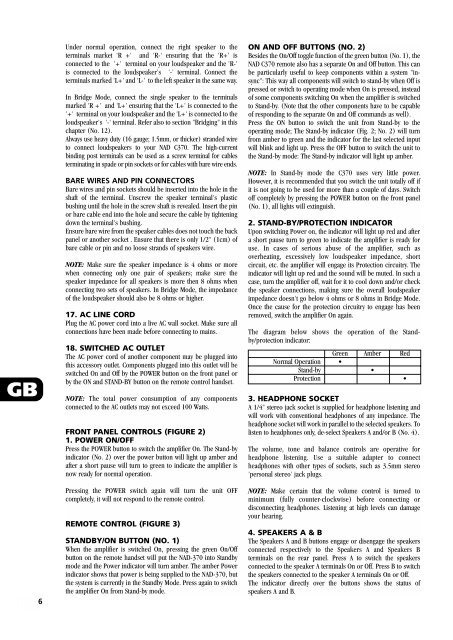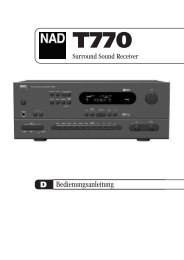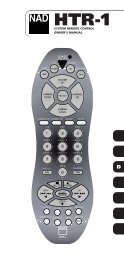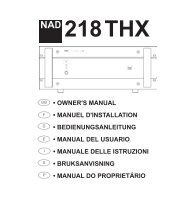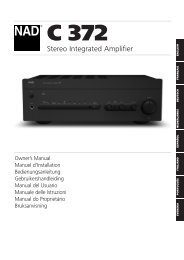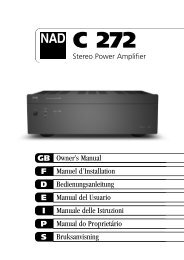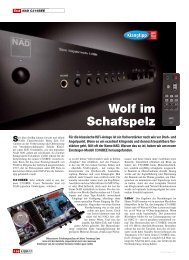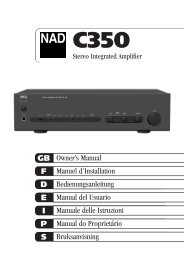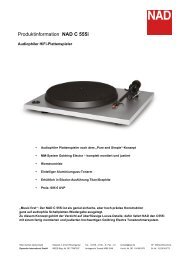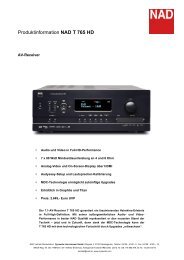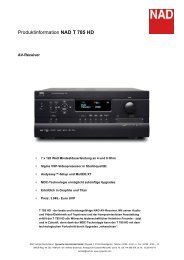C370 manual - NAD
C370 manual - NAD
C370 manual - NAD
Create successful ePaper yourself
Turn your PDF publications into a flip-book with our unique Google optimized e-Paper software.
GB<br />
6<br />
Under normal operation, connect the right speaker to the<br />
terminals market 'R +' and 'R-' ensuring that the 'R+' is<br />
connected to the '+' terminal on your loudspeaker and the 'R-'<br />
is connected to the loudspeaker's '-' terminal. Connect the<br />
terminals marked 'L+' and 'L-' to the left speaker in the same way.<br />
In Bridge Mode, connect the single speaker to the terminals<br />
marked 'R +' and 'L+' ensuring that the 'L+' is connected to the<br />
'+' terminal on your loudspeaker and the 'L+' is connected to the<br />
loudspeaker's '-' terminal. Refer also to section "Bridging" in this<br />
chapter (No. 12).<br />
Always use heavy duty (16 gauge; 1.5mm, or thicker) stranded wire<br />
to connect loudspeakers to your <strong>NAD</strong> <strong>C370</strong>. The high-current<br />
binding post terminals can be used as a screw terminal for cables<br />
terminating in spade or pin sockets or for cables with bare wire ends.<br />
BARE WIRES AND PIN CONNECTORS<br />
Bare wires and pin sockets should be inserted into the hole in the<br />
shaft of the terminal. Unscrew the speaker terminal's plastic<br />
bushing until the hole in the screw shaft is revealed. Insert the pin<br />
or bare cable end into the hole and secure the cable by tightening<br />
down the terminal's bushing.<br />
Ensure bare wire from the speaker cables does not touch the back<br />
panel or another socket . Ensure that there is only 1/2" (1cm) of<br />
bare cable or pin and no loose strands of speakers wire.<br />
NOTE: Make sure the speaker impedance is 4 ohms or more<br />
when connecting only one pair of speakers; make sure the<br />
speaker impedance for all speakers is more then 8 ohms when<br />
connecting two sets of speakers. In Bridge Mode, the impedance<br />
of the loudspeaker should also be 8 ohms or higher.<br />
17. AC LINE CORD<br />
Plug the AC power cord into a live AC wall socket. Make sure all<br />
connections have been made before connecting to mains.<br />
18. SWITCHED AC OUTLET<br />
The AC power cord of another component may be plugged into<br />
this accessory outlet. Components plugged into this outlet will be<br />
switched On and Off by the POWER button on the front panel or<br />
by the ON and STAND-BY button on the remote control handset.<br />
NOTE: The total power consumption of any components<br />
connected to the AC outlets may not exceed 100 Watts.<br />
FRONT PANEL CONTROLS (FIGURE 2)<br />
1. POWER ON/OFF<br />
Press the POWER button to switch the amplifier On. The Stand-by<br />
indicator (No. 2) over the power button will light up amber and<br />
after a short pause will turn to green to indicate the amplifier is<br />
now ready for normal operation.<br />
Pressing the POWER switch again will turn the unit OFF<br />
completely, it will not respond to the remote control.<br />
REMOTE CONTROL (FIGURE 3)<br />
STANDBY/ON BUTTON (NO. 1)<br />
When the amplifier is switched On, pressing the green On/Off<br />
button on the remote handset will put the <strong>NAD</strong>-370 into Standby<br />
mode and the Power indicator will turn amber. The amber Power<br />
indicator shows that power is being supplied to the <strong>NAD</strong>-370, but<br />
the system is currently in the Standby Mode. Press again to switch<br />
the amplifier On from Stand-by mode.<br />
ON AND OFF BUTTONS (NO. 2)<br />
Besides the On/Off toggle function of the green button (No. 1), the<br />
<strong>NAD</strong> <strong>C370</strong> remote also has a separate On and Off button. This can<br />
be particularly useful to keep components within a system "insync":<br />
This way all components will switch to stand-by when Off is<br />
pressed or switch to operating mode when On is pressed, instead<br />
of some components switching On when the amplifier is switched<br />
to Stand-by. (Note that the other components have to be capable<br />
of responding to the separate On and Off commands as well).<br />
Press the ON button to switch the unit from Stand-by to the<br />
operating mode; The Stand-by indicator (Fig. 2; No. 2) will turn<br />
from amber to green and the indicator for the last selected input<br />
will blink and light up. Press the OFF button to switch the unit to<br />
the Stand-by mode: The Stand-by indicator will light up amber.<br />
NOTE: In Stand-by mode the <strong>C370</strong> uses very little power.<br />
However, it is recommended that you switch the unit totally off if<br />
it is not going to be used for more than a couple of days. Switch<br />
off completely by pressing the POWER button on the front panel<br />
(No. 1), all lights will extinguish.<br />
2. STAND-BY/PROTECTION INDICATOR<br />
Upon switching Power on, the indicator will light up red and after<br />
a short pause turn to green to indicate the amplifier is ready for<br />
use. In cases of serious abuse of the amplifier, such as<br />
overheating, excessively low loudspeaker impedance, short<br />
circuit, etc. the amplifier will engage its Protection circuitry. The<br />
indicator will light up red and the sound will be muted. In such a<br />
case, turn the amplifier off, wait for it to cool down and/or check<br />
the speaker connections, making sure the overall loudspeaker<br />
impedance doesn't go below 4 ohms or 8 ohms in Bridge Mode.<br />
Once the cause for the protection circuitry to engage has been<br />
removed, switch the amplifier On again.<br />
The diagram below shows the operation of the Standby/protection<br />
indicator:<br />
Green Amber Red<br />
Normal Operation •<br />
Stand-by •<br />
Protection •<br />
3. HEADPHONE SOCKET<br />
A 1/4" stereo jack socket is supplied for headphone listening and<br />
will work with conventional headphones of any impedance. The<br />
headphone socket will work in parallel to the selected speakers. To<br />
listen to headphones only, de-select Speakers A and/or B (No. 4).<br />
The volume, tone and balance controls are operative for<br />
headphone listening. Use a suitable adapter to connect<br />
headphones with other types of sockets, such as 3.5mm stereo<br />
'personal stereo' jack plugs.<br />
NOTE: Make certain that the volume control is turned to<br />
minimum (fully counter-clockwise) before connecting or<br />
disconnecting headphones. Listening at high levels can damage<br />
your hearing.<br />
4. SPEAKERS A & B<br />
The Speakers A and B buttons engage or disengage the speakers<br />
connected respectively to the Speakers A and Speakers B<br />
terminals on the rear panel. Press A to switch the speakers<br />
connected to the speaker A terminals On or Off. Press B to switch<br />
the speakers connected to the speaker A terminals On or Off.<br />
The indicator directly over the buttons shows the status of<br />
speakers A and B.


